Publications so far
0
| 1. | 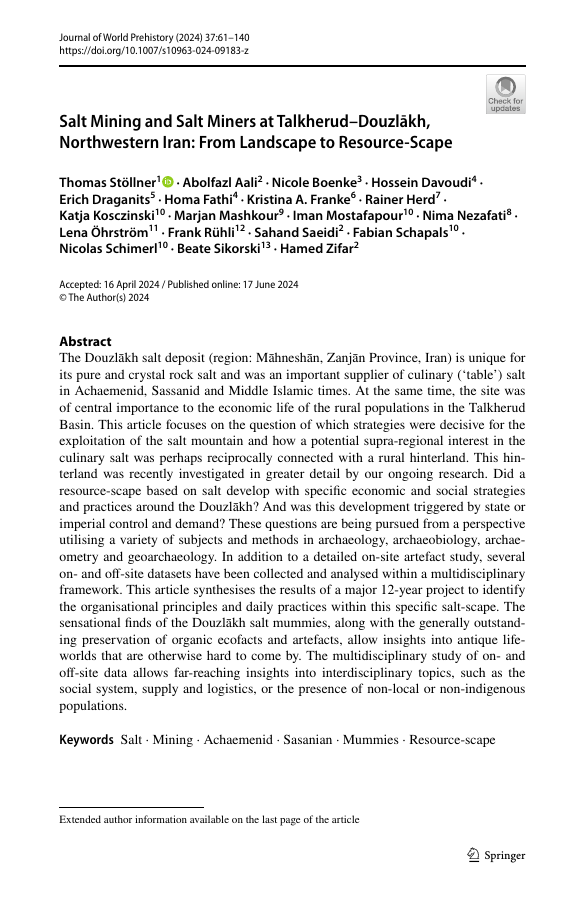 | Stöllner, Thomas; Aali, Abolfazl; Boenke, Nicole; Davoudi, Hossein; Draganits, Erich; Fathi, Homa; Franke, Kristina A.; Herd, Rainer; Kosczinski, Katja; Mashkour, Marjan; Mostafapour, Iman; Nezafati, Nima; Öhrström, Lena Maria; Rühli, Frank; Saeidi, Sahand; Schapals, Fabian; Schimerl, Nicolas; Sikorski, Beate; Zifar, Hamed: Salt Mining and Salt Miners at Talkherud–Douzlākh, Northwestern Iran: From Landscape to Resource‑Scape. In: Journal of World Prehistory, vol. 37, pp. 61-140, 2024. (Type: Journal Article | Abstract | Links | BibTeX)@article{nokey,The Douzlākh salt deposit (region: Māhneshān, Zanjān Province, Iran) is unique for its pure and crystal rock salt and was an important supplier of culinary (‘table’) salt in Achaemenid, Sassanid and Middle Islamic times. At the same time, the site was of central importance to the economic life of the rural populations in the Talkherud Basin. This article focuses on the question of which strategies were decisive for the exploitation of the salt mountain and how a potential supra-regional interest in the culinary salt was perhaps reciprocally connected with a rural hinterland. This hinterland was recently investigated in greater detail by our ongoing research. Did aresource-scape based on salt develop with specific economic and social strategies and practices around the Douzlākh? And was this development triggered by state or imperial control and demand? These questions are being pursued from a perspective utilising a variety of subjects and methods in archaeology, archaeobiology, archaeometry and geoarchaeology. In addition to a detailed on-site artefact study, several on- and off-site datasets have been collected and analysed within a multidisciplinary framework. This article synthesises the results of a major 12-year project to identify the organisational principles and daily practices within this specific salt-scape. The sensational finds of the Douzlākh salt mummies, along with the generally outstanding preservation of organic ecofacts and artefacts, allow insights into antique life-worlds that are otherwise hard to come by. The multidisciplinary study of on- and off-site data allows far-reaching insights into interdisciplinary topics, such as the social system, supply and logistics, or the presence of non-local or non-indigenous populations. |
| 2. |  | Labisi, Guiseppe: Squinches and Semi-domes Between the Late Sasanian and Early Islamic Periods. In: Iran: Journal of the British Institute of Persian Studies, iss. 28, no. 2, pp. 236-49, 2022. (Type: Journal Article | Abstract | Links | BibTeX)@article{nokey,The aim of this paper is to present a first attempt at a comprehensive classification of squinches related to semi-domes, in Persian kāna pūsh, in Greater Syria, Mesopotamia and Iran between the late Sasanian and early Islamic periods. This feature is a characteristic of the Persian architectural tradition: all the preserved examples are in buildings of considerable importance (most are related to the architecture of the élites) and demonstrate a typological evolution. Furthermore, their origin can also be backdated to between the late Sasanian and early Islamic periods. |
| 3. |  | Djamali, Morteza; Rashidian, Elnaz; Capano, Manuela; Askari-Chaverdi, Alireza; Faucherre, Nicolas; Guibal, Frédéric; Northedge, Alastair; Tuna, Thibaut; Bard, Edouard: An Absolute Radiocarbon Chronology for the World Heritage Site of Sarvestan (SW Iran): A Late Sasanian Heritage in Early Islamic Era. In: Archaeometry, iss. 64, no. 2, pp. 545–59, 2021. (Type: Journal Article | Abstract | Links | BibTeX)@article{nokey,This study presents a new precise radiocarbon chronology for the World Heritage site of Sarvestan (SW Iran). The monument is a key construction in the history of architecture because it is a typical Sasanian construction built during the late Sasanian or early Islamic period. Previous attempts to date the monument have suggested the ages ranging from the middle Sasanian (fifth century CE) to early Abbasid (ninth century CE) era. These age estimations are based on the analysis of architectural plans and techniques, and a few radiocarbon dates with very large age uncertainties. This paper presents the results of a systematic radiocarbon dating of timbers in the walls and charcoals in plaster mortars used in the main dome of the monument. It further applies wiggle matching technique and R_Combine function to substantially reduce the age uncertainties in wood sections. The results indicate that a major construction work was undertaken sometime between 658 and 683 CE, the century of the invasion of Fars by Muslim Arabs. This finding pushes back the age of Sarvestan for two centuries and suggests that the monument was built at the transitional period between Sasanian to Islamic era. Sarvestan would have been an architectural project designed and possibly initiated during the late Sasanian period but mainly accomplished during the second half of the seventh century CE. It can thus be considered a late Sasanian heritage in early Islamic period. Its construction at a time of political unrest further suggests that some areas of Fars may have benefited from certain socio-political stabilities during the expansion of Islam into the east at mid- to late seventh century CE. |
| 4. | 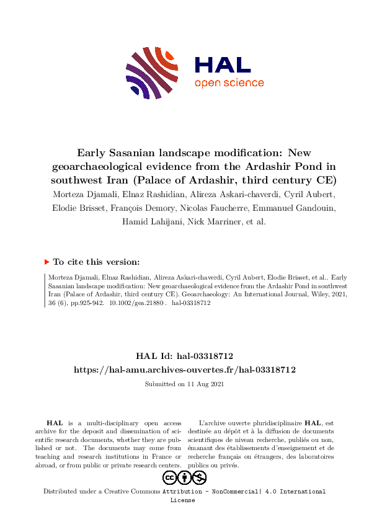 | Djamali, Morteza; Rashidian, Elnaz; Askari-Chaverdi, Alireza; Aubert, Cyril; Brisset, Elodie; Demory, François; Faucherre, Nicolas; Gandouin, Emmanuel; Lahijani, Hamid; Marriner, Nick; Naderi-Beni, Abdolmajid; Parnell, Andrew: Early Sasanian Landscape Modification: New Geoarchaeological Evidence From the Ardashir Pond in Southwest Iran (Palace of Ardashir, Third Century CE). In: Geoarchaeology, iss. 36, pp. 925–42, 2021. (Type: Journal Article | Abstract | Links | BibTeX)@article{nokey,The Sasanian period (224–651 CE) marked an era of large-scale urban projects in southwest Asia, including Iran's semi-arid highlands, with particular efforts to manipulate water bodies. This study presents a recent interdisciplinary investigation of a spring-fed pond at the entrance of the Palace of Ardashir (Firuzabad plain, southwest Iran), part of a recently registered World Heritage site. Historical accounts suggest that the entire water system of the plain, including the pond, underwent a hydraulic re-organization at the beginning of the Sasanian period, a fact that has never been investigated geoarchaeologically. A series of sediment cores were retrieved from the pond to probe its evolution and examine the extent of its landscape modification. The cores were sedimentologically described and radiocarbon-dated with age–depth models established based on 57 AMS (accelerator mass spectrometry) 14C dates to understand the basin's depositional history. The results indicate that (i) Ardashir Pond has existed as part of a larger wetland complex since at least 4500 years ago, (ii) it was substantially enlarged at the beginning of the Sasanian era, and (iii) it was abandoned at the end of the Sasanian period. The Ardashir Pond is one of the first geoarchaeologically investigated case studies to demonstrate the Sasanian landscape in the framework of the “Iranshahr” sociopolitical concept. |
| 5. |  | Stöllner, Thomas; Aali, Abolfazl: Einblicke in eine Katastrophe. Das Salzbergwerk von Douzlākh bei Chehrābād. In: Karlsruhe, Badisches Landesmuseum (Ed.): vol. Die Perser. Am Hof der Großkönige, pp. 116-20, WBG/Philipp von Zabern, Darmstadt, 2021, ISBN: ISBN 978-3-8053-5276-5. (Type: Book Chapter | Links | BibTeX)@inbook{nokey, |
| 6. |  | Stöllner, Thomas; Aali, Abolfazl: Long-Term Salt Mining in Chehrābād: Resilient Strategies in Accessing Mineral Resources at the Iranian Highlands. In: Pearls, Politics and Pistachios: Essays in Anthropology and Memories on the Occasion of Susan Pollock’s 65th Birthday, pp. 352-369, Ex Oriente/Propylaeum, Berlin/Heidelberg, 2021. (Type: Book Chapter | Links | BibTeX)@inbook{nokey, |
| 7. | 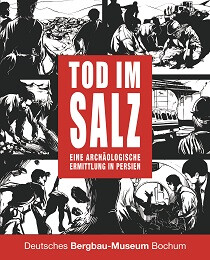 | Stöllner, Thomas; Aali, Abolfazl; Kashani, Natascha Bagherpour (Ed.): Tod im Salz. Eine archäologische Ermittlung in Persien. Nünnerich-Asmus Verlag & Media GmbH, 2020, ISBN: 978-3-96176-141-8. (Type: Book | Abstract | Links | BibTeX)@book{nokey,Since the first discoveries in 1993 bodies or body-parts of eight humans have been discovered at the salt-mine of Douzlākh at Chehrābād. These bodies allow a reconstruction of their lives as workers during the different operation periods. By involving many different scientific fields, it became possible to investigate their palaeo-medical aspects, their diet and their health status as well the causes of their death and their involvement into different aspects of the mining operation and logistics of the mine. It is possible not only to reconstruct three different catastrophes during the Achaemenid, the early and the late Sasanian times but also to understand the social aspects of the working people. The Achaemenid miners certainly came from abroad but already stayed a while in the region, apart from the young miner no. 4 who seems to have arrived shortly before the catastrophe. This group of migrants possibly were sent within a “bandaka”, an Achaemenid labour duty. The Sassanian miners partly came from a “regional” background but also came shortly before their deaths. Saltman 1 is interesting as he is an older individual who possibly had a special role within the miners. Mining at Douzlakh was predominantly operated in periods of strong centralized political systems when governmental activities could be organized over longer distances. |
| 8. |  | Aali, Abolfazl; Stöllner, Thomas; Firuzmandi, Bahman: Analyzing Archaeological Finds from the Chehrabad Salt Mine. In: Journal of Archaeological Studies, vol. 11, no. 2, pp. 191-210, 2019. (Type: Journal Article | Abstract | Links | BibTeX)@article{nokey,The Chehrabad salt mine is one of the rare ancient salt mine in the world and the only identified salt mine in Iran which has evidences of salt extracting over a long time span from 500 BC to modern times. According to the field researches conducted so far, in the excavated area, mining activities are proven to be in use in the Achaemenid, Sasanian, Middle and Late Islamic periods. After the accidental discoveries in 1993 and 2004, several season of excavation and archaeological surveys, have been carried out in the mine and around it. Archaeological researches brought to light interesting results concerning the techniques, periods and extracting tools, also relation between salt mine and the archaeological sites around it. Digging deep tunnels inside the salt rock deposits in different dimensions and sizes and using the various extraction tools can be seen in the excavated area with the difference in details in all the aforementioned periods. The long- term salt extraction activities and multi- periodic collapse of the tunnels, have resulted the formation of various layers such as fall, occupation, mining and erosion layers in different parts of the mine and the filling many of its old tunnels. According to documents, Most of the discovered human remains were probably non- native miners who died during catastrophic mining accidents and mummified naturally. |
| 9. | 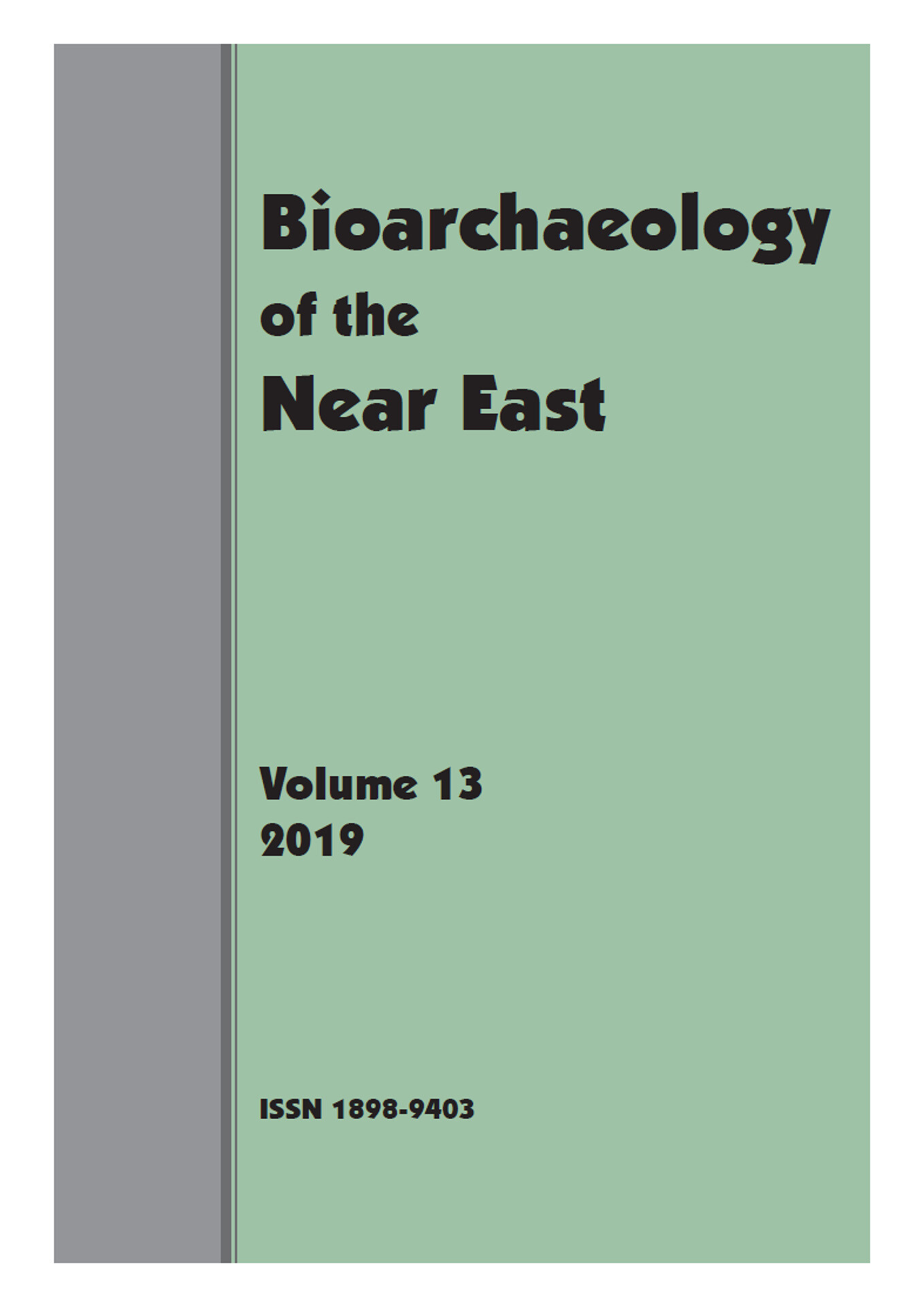 | Nasab, Hamed Vahdati; Aali, Abolfazl; Kazzazi, Mandan; Pollard, Mark; Stöllner, Thomas: Reappraisal of the number of salt mummies identified in Chehrābād Salt Mine, Zanjan, Iran. In: Bioarchaeology of the Near East, vol. 13, pp. 23-47, 2019. (Type: Journal Article | Abstract | Links | BibTeX)@article{nokey,The Chehrābād Salt Mine mummies were first discovered in 1993. So far, six individuals have been identified in the mine. Three (1, 2, and 3) were found accidentally by miners, while another three (4, 5, and 6) were discovered through systematic archaeological excavations. This article shows that there are two more individuals represented in the collection, bringing the total number of mummies to eight. Osteological examination confirms that the extra bones initially placed with Salt Man 1 belong to another individual, possibly a young adult male, of unknown date, called Salt Man 7. In addition, results from AMS dating of an extra piece of mandible, which was originally placed with the skeletal remains of Salt Man 3, indicates that this specimen does not belong to this individual; it was removed from the collection and renamed as Salt Man 8. The osteological analysis of the bone remains of Salt Man 8 suggests that this individual might also be a young male. |
| 10. | 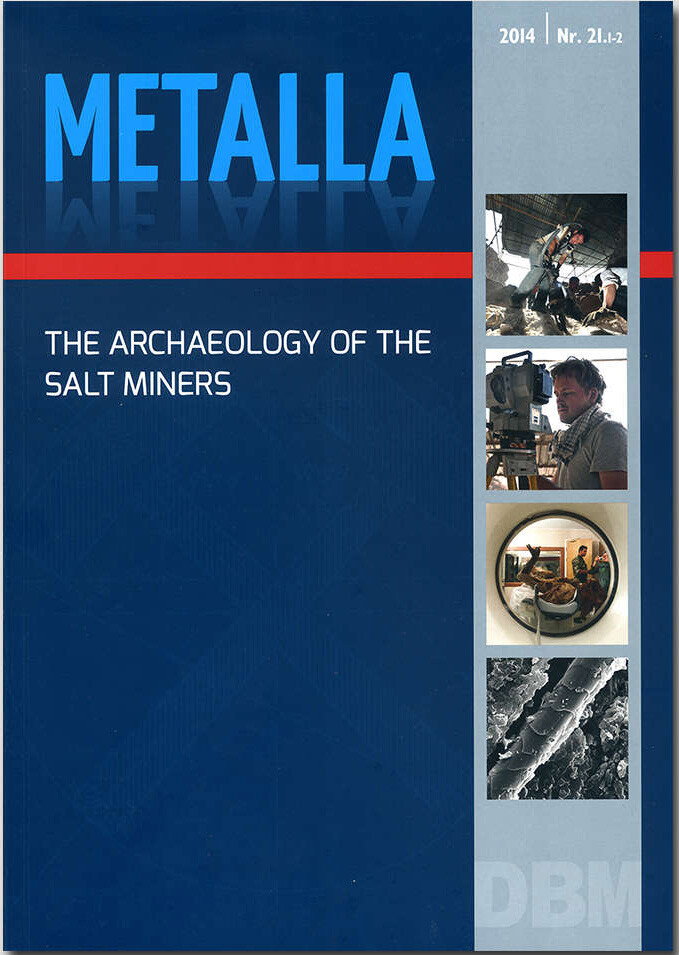 | Aali, Abolfazl; Stöllner, Thomas (Ed.): The Archaeology of the Salt Miners. Interdisciplinary Research 2010-2014.. 2015, ISSN: 0947-6229. (Type: Book | Links | BibTeX)@book{nokey, |
| 11. | und Daniel Steiniger, Raimar W. Kory: Gedanken zur Sasanidischen Binnen- und Hochseeschiffahrt. In: Dobiat, Claus; Leidorf, Klaus (Ed.): Studien in memoriam Wilhelm Schüle
, pp. 253-280, Leidorf, 2001. (Type: Book Chapter | Links | BibTeX)@inbook{nokey, | |
| 12. | Herrmann, Georgina: Parthian and Sasanian Saddlery. New Light from the Roman West. In: de Meyer, L.; Haerinck, E. (Ed.): Archaeologia Iraníca et Orientalis. Miscellanea in Honorem Louis Vanden Berghe (1989)
, vol. 2, pp. 757-809, Peeters, 1989. (Type: Book Chapter | BibTeX)@inbook{nokey, | |
| 13. | 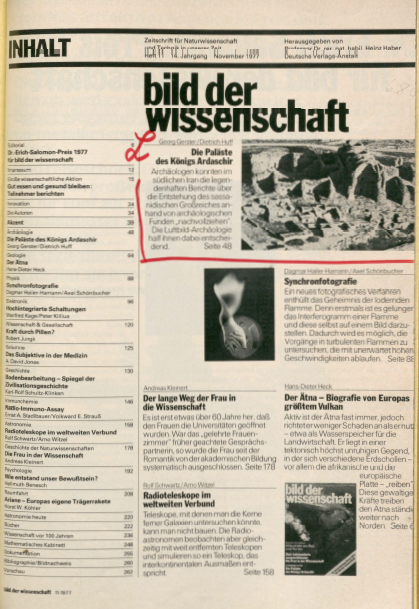 | Huff, Dietrich; Gerster, Georg: Die Paläste des Königs Ardaschir: Firuzabad-Wiege des Sassanidenreiches . In: Bild der Wissenschaft, vol. 14, no. 11, pp. 18-63, 1977. (Type: Journal Article | BibTeX)@article{nokey, |
| 14. | Bowman, John: The Sasanian Church in the Kharg Island. In: Acta Iranica, vol. 1, pp. 217-220, 1974. (Type: Journal Article | BibTeX)@article{nokey, | |
| 15. | 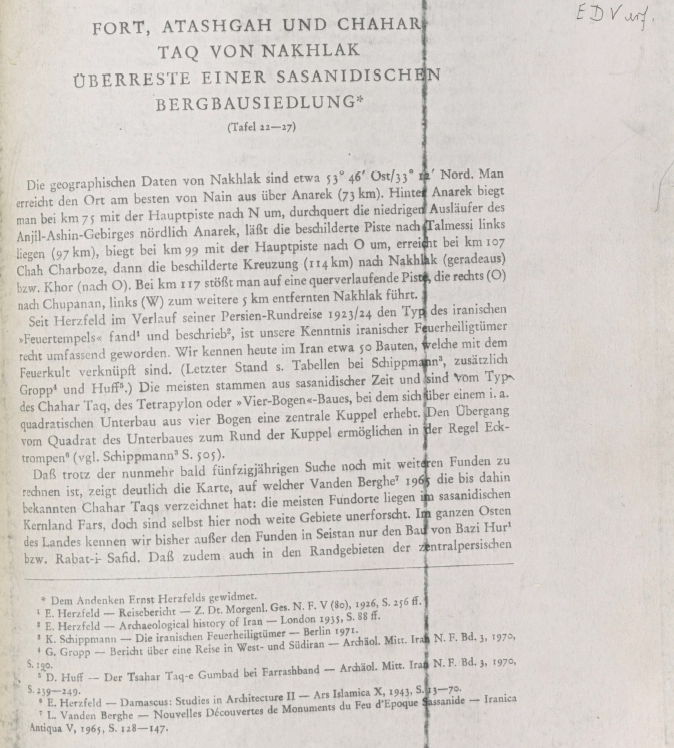 | Hallier, Ulrich W.: Fort, Atashgah und Chahar Taq von Nakhlak, Überreste einer Sasanidischen Bergbausiedlung. In: Archäologische Mitteilungen aus Iran, vol. N.F. 5, pp. 285-307, 1972. (Type: Journal Article | BibTeX)@article{nokey, |
| 16. | 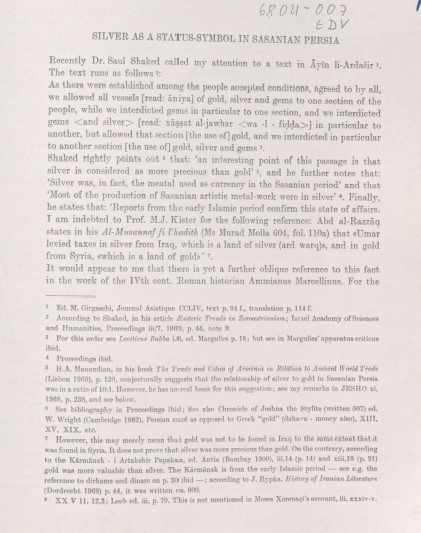 | Sperber, Daniel: Silver as a status-symbol in Sasanian Persia. In: Persica, vol. 5, pp. 103-105, 1970. (Type: Journal Article | BibTeX)@article{nokey, |
| 17. |  | von Petrikovits, Harald: Die Herkunft einer sasanidischen Silberflaschenform. In: Trierer Zeitschrift, vol. 32, pp. 323-332, 1969. (Type: Journal Article | BibTeX)@article{nokey, |
| 18. |  | Naumann, R.: Sassanidische Feueraltäre. In: Iranica Antiqua, vol. 7, pp. 72-76, 1967. (Type: Journal Article | Links | BibTeX)@article{nokey, |
| 19. |  | Berghe, Louis Vanden: Nouvelles decouvertes de monuments du feu d'epoque Sassanide. In: Iranica Antiqua, iss. 5, pp. 128-147, 1965. (Type: Journal Article | Links | BibTeX)@article{nokey, |
2024 |
|
 | Stöllner, Thomas; Aali, Abolfazl; Boenke, Nicole; Davoudi, Hossein; Draganits, Erich; Fathi, Homa; Franke, Kristina A.; Herd, Rainer; Kosczinski, Katja; Mashkour, Marjan; Mostafapour, Iman; Nezafati, Nima; Öhrström, Lena Maria; Rühli, Frank; Saeidi, Sahand; Schapals, Fabian; Schimerl, Nicolas; Sikorski, Beate; Zifar, Hamed: Salt Mining and Salt Miners at Talkherud–Douzlākh, Northwestern Iran: From Landscape to Resource‑Scape. In: Journal of World Prehistory, vol. 37, pp. 61-140, 2024. (Type: Journal Article | Abstract | Links | BibTeX | Tags: Achaemenid, Mining, Resources, Salt, Sasanian)@article{nokey,The Douzlākh salt deposit (region: Māhneshān, Zanjān Province, Iran) is unique for its pure and crystal rock salt and was an important supplier of culinary (‘table’) salt in Achaemenid, Sassanid and Middle Islamic times. At the same time, the site was of central importance to the economic life of the rural populations in the Talkherud Basin. This article focuses on the question of which strategies were decisive for the exploitation of the salt mountain and how a potential supra-regional interest in the culinary salt was perhaps reciprocally connected with a rural hinterland. This hinterland was recently investigated in greater detail by our ongoing research. Did aresource-scape based on salt develop with specific economic and social strategies and practices around the Douzlākh? And was this development triggered by state or imperial control and demand? These questions are being pursued from a perspective utilising a variety of subjects and methods in archaeology, archaeobiology, archaeometry and geoarchaeology. In addition to a detailed on-site artefact study, several on- and off-site datasets have been collected and analysed within a multidisciplinary framework. This article synthesises the results of a major 12-year project to identify the organisational principles and daily practices within this specific salt-scape. The sensational finds of the Douzlākh salt mummies, along with the generally outstanding preservation of organic ecofacts and artefacts, allow insights into antique life-worlds that are otherwise hard to come by. The multidisciplinary study of on- and off-site data allows far-reaching insights into interdisciplinary topics, such as the social system, supply and logistics, or the presence of non-local or non-indigenous populations. |
2022 |
|
 | Labisi, Guiseppe: Squinches and Semi-domes Between the Late Sasanian and Early Islamic Periods. In: Iran: Journal of the British Institute of Persian Studies, iss. 28, no. 2, pp. 236-49, 2022. (Type: Journal Article | Abstract | Links | BibTeX | Tags: Architecture, Islamic era, Sasanian, Social, social relations, Syria)@article{nokey,The aim of this paper is to present a first attempt at a comprehensive classification of squinches related to semi-domes, in Persian kāna pūsh, in Greater Syria, Mesopotamia and Iran between the late Sasanian and early Islamic periods. This feature is a characteristic of the Persian architectural tradition: all the preserved examples are in buildings of considerable importance (most are related to the architecture of the élites) and demonstrate a typological evolution. Furthermore, their origin can also be backdated to between the late Sasanian and early Islamic periods. |
2021 |
|
 | Djamali, Morteza; Rashidian, Elnaz; Capano, Manuela; Askari-Chaverdi, Alireza; Faucherre, Nicolas; Guibal, Frédéric; Northedge, Alastair; Tuna, Thibaut; Bard, Edouard: An Absolute Radiocarbon Chronology for the World Heritage Site of Sarvestan (SW Iran): A Late Sasanian Heritage in Early Islamic Era. In: Archaeometry, iss. 64, no. 2, pp. 545–59, 2021. (Type: Journal Article | Abstract | Links | BibTeX | Tags: Dating, Islamic era, Sasanian)@article{nokey,This study presents a new precise radiocarbon chronology for the World Heritage site of Sarvestan (SW Iran). The monument is a key construction in the history of architecture because it is a typical Sasanian construction built during the late Sasanian or early Islamic period. Previous attempts to date the monument have suggested the ages ranging from the middle Sasanian (fifth century CE) to early Abbasid (ninth century CE) era. These age estimations are based on the analysis of architectural plans and techniques, and a few radiocarbon dates with very large age uncertainties. This paper presents the results of a systematic radiocarbon dating of timbers in the walls and charcoals in plaster mortars used in the main dome of the monument. It further applies wiggle matching technique and R_Combine function to substantially reduce the age uncertainties in wood sections. The results indicate that a major construction work was undertaken sometime between 658 and 683 CE, the century of the invasion of Fars by Muslim Arabs. This finding pushes back the age of Sarvestan for two centuries and suggests that the monument was built at the transitional period between Sasanian to Islamic era. Sarvestan would have been an architectural project designed and possibly initiated during the late Sasanian period but mainly accomplished during the second half of the seventh century CE. It can thus be considered a late Sasanian heritage in early Islamic period. Its construction at a time of political unrest further suggests that some areas of Fars may have benefited from certain socio-political stabilities during the expansion of Islam into the east at mid- to late seventh century CE. |
 | Djamali, Morteza; Rashidian, Elnaz; Askari-Chaverdi, Alireza; Aubert, Cyril; Brisset, Elodie; Demory, François; Faucherre, Nicolas; Gandouin, Emmanuel; Lahijani, Hamid; Marriner, Nick; Naderi-Beni, Abdolmajid; Parnell, Andrew: Early Sasanian Landscape Modification: New Geoarchaeological Evidence From the Ardashir Pond in Southwest Iran (Palace of Ardashir, Third Century CE). In: Geoarchaeology, iss. 36, pp. 925–42, 2021. (Type: Journal Article | Abstract | Links | BibTeX | Tags: Fars, Landscape, Sasanian)@article{nokey,The Sasanian period (224–651 CE) marked an era of large-scale urban projects in southwest Asia, including Iran's semi-arid highlands, with particular efforts to manipulate water bodies. This study presents a recent interdisciplinary investigation of a spring-fed pond at the entrance of the Palace of Ardashir (Firuzabad plain, southwest Iran), part of a recently registered World Heritage site. Historical accounts suggest that the entire water system of the plain, including the pond, underwent a hydraulic re-organization at the beginning of the Sasanian period, a fact that has never been investigated geoarchaeologically. A series of sediment cores were retrieved from the pond to probe its evolution and examine the extent of its landscape modification. The cores were sedimentologically described and radiocarbon-dated with age–depth models established based on 57 AMS (accelerator mass spectrometry) 14C dates to understand the basin's depositional history. The results indicate that (i) Ardashir Pond has existed as part of a larger wetland complex since at least 4500 years ago, (ii) it was substantially enlarged at the beginning of the Sasanian era, and (iii) it was abandoned at the end of the Sasanian period. The Ardashir Pond is one of the first geoarchaeologically investigated case studies to demonstrate the Sasanian landscape in the framework of the “Iranshahr” sociopolitical concept. |
 | Stöllner, Thomas; Aali, Abolfazl: Einblicke in eine Katastrophe. Das Salzbergwerk von Douzlākh bei Chehrābād. In: Karlsruhe, Badisches Landesmuseum (Ed.): vol. Die Perser. Am Hof der Großkönige, pp. 116-20, WBG/Philipp von Zabern, Darmstadt, 2021, ISBN: ISBN 978-3-8053-5276-5. (Type: Book Chapter | Links | BibTeX | Tags: Achaemenid, Administration, Institutions, Mining, Salt, Sasanian, Zanjan)@inbook{nokey, |
 | Stöllner, Thomas; Aali, Abolfazl: Long-Term Salt Mining in Chehrābād: Resilient Strategies in Accessing Mineral Resources at the Iranian Highlands. In: Pearls, Politics and Pistachios: Essays in Anthropology and Memories on the Occasion of Susan Pollock’s 65th Birthday, pp. 352-369, Ex Oriente/Propylaeum, Berlin/Heidelberg, 2021. (Type: Book Chapter | Links | BibTeX | Tags: Achaemenid, Administration, Bronze Age, Chalcolithic, Institutions, Iron Age, Islamic era, Minerals, Mining, Neolithic, Resilience, Resources, Salt, Sasanian, Zanjan)@inbook{nokey, |
2020 |
|
 | Stöllner, Thomas; Aali, Abolfazl; Kashani, Natascha Bagherpour (Ed.): Tod im Salz. Eine archäologische Ermittlung in Persien. Nünnerich-Asmus Verlag & Media GmbH, 2020, ISBN: 978-3-96176-141-8. (Type: Book | Abstract | Links | BibTeX | Tags: Achaemenid, Administration, Bronze Age, Chalcolithic, Institutions, Iron Age, Islamic era, Minerals, Mining, Mobility, Neolithic, Salt, Sasanian, Zanjan)@book{nokey,Since the first discoveries in 1993 bodies or body-parts of eight humans have been discovered at the salt-mine of Douzlākh at Chehrābād. These bodies allow a reconstruction of their lives as workers during the different operation periods. By involving many different scientific fields, it became possible to investigate their palaeo-medical aspects, their diet and their health status as well the causes of their death and their involvement into different aspects of the mining operation and logistics of the mine. It is possible not only to reconstruct three different catastrophes during the Achaemenid, the early and the late Sasanian times but also to understand the social aspects of the working people. The Achaemenid miners certainly came from abroad but already stayed a while in the region, apart from the young miner no. 4 who seems to have arrived shortly before the catastrophe. This group of migrants possibly were sent within a “bandaka”, an Achaemenid labour duty. The Sassanian miners partly came from a “regional” background but also came shortly before their deaths. Saltman 1 is interesting as he is an older individual who possibly had a special role within the miners. Mining at Douzlakh was predominantly operated in periods of strong centralized political systems when governmental activities could be organized over longer distances. |
2019 |
|
 | Aali, Abolfazl; Stöllner, Thomas; Firuzmandi, Bahman: Analyzing Archaeological Finds from the Chehrabad Salt Mine. In: Journal of Archaeological Studies, vol. 11, no. 2, pp. 191-210, 2019. (Type: Journal Article | Abstract | Links | BibTeX | Tags: Achaemenid, Mining, Resilience, Resources, Sasanian, Zanjan)@article{nokey,The Chehrabad salt mine is one of the rare ancient salt mine in the world and the only identified salt mine in Iran which has evidences of salt extracting over a long time span from 500 BC to modern times. According to the field researches conducted so far, in the excavated area, mining activities are proven to be in use in the Achaemenid, Sasanian, Middle and Late Islamic periods. After the accidental discoveries in 1993 and 2004, several season of excavation and archaeological surveys, have been carried out in the mine and around it. Archaeological researches brought to light interesting results concerning the techniques, periods and extracting tools, also relation between salt mine and the archaeological sites around it. Digging deep tunnels inside the salt rock deposits in different dimensions and sizes and using the various extraction tools can be seen in the excavated area with the difference in details in all the aforementioned periods. The long- term salt extraction activities and multi- periodic collapse of the tunnels, have resulted the formation of various layers such as fall, occupation, mining and erosion layers in different parts of the mine and the filling many of its old tunnels. According to documents, Most of the discovered human remains were probably non- native miners who died during catastrophic mining accidents and mummified naturally. |
 | Nasab, Hamed Vahdati; Aali, Abolfazl; Kazzazi, Mandan; Pollard, Mark; Stöllner, Thomas: Reappraisal of the number of salt mummies identified in Chehrābād Salt Mine, Zanjan, Iran. In: Bioarchaeology of the Near East, vol. 13, pp. 23-47, 2019. (Type: Journal Article | Abstract | Links | BibTeX | Tags: Achaemenid, Mining, Resilience, Resources, Sasanian, Zanjan)@article{nokey,The Chehrābād Salt Mine mummies were first discovered in 1993. So far, six individuals have been identified in the mine. Three (1, 2, and 3) were found accidentally by miners, while another three (4, 5, and 6) were discovered through systematic archaeological excavations. This article shows that there are two more individuals represented in the collection, bringing the total number of mummies to eight. Osteological examination confirms that the extra bones initially placed with Salt Man 1 belong to another individual, possibly a young adult male, of unknown date, called Salt Man 7. In addition, results from AMS dating of an extra piece of mandible, which was originally placed with the skeletal remains of Salt Man 3, indicates that this specimen does not belong to this individual; it was removed from the collection and renamed as Salt Man 8. The osteological analysis of the bone remains of Salt Man 8 suggests that this individual might also be a young male. |
2015 |
|
 | Aali, Abolfazl; Stöllner, Thomas (Ed.): The Archaeology of the Salt Miners. Interdisciplinary Research 2010-2014.. 2015, ISSN: 0947-6229. (Type: Book | Links | BibTeX | Tags: Achaemenid, Mining, Resilience, Resources, Sasanian, Zanjan)@book{nokey, |
2001 |
|
und Daniel Steiniger, Raimar W. Kory: Gedanken zur Sasanidischen Binnen- und Hochseeschiffahrt. In: Dobiat, Claus; Leidorf, Klaus (Ed.): Studien in memoriam Wilhelm Schüle
, pp. 253-280, Leidorf, 2001. (Type: Book Chapter | Links | BibTeX | Tags: Sasanian)@inbook{nokey, | |
1989 |
|
Herrmann, Georgina: Parthian and Sasanian Saddlery. New Light from the Roman West. In: de Meyer, L.; Haerinck, E. (Ed.): Archaeologia Iraníca et Orientalis. Miscellanea in Honorem Louis Vanden Berghe (1989)
, vol. 2, pp. 757-809, Peeters, 1989. (Type: Book Chapter | BibTeX | Tags: Parthian, Sasanian)@inbook{nokey, | |
1977 |
|
 | Huff, Dietrich; Gerster, Georg: Die Paläste des Königs Ardaschir: Firuzabad-Wiege des Sassanidenreiches . In: Bild der Wissenschaft, vol. 14, no. 11, pp. 18-63, 1977. (Type: Journal Article | BibTeX | Tags: Sasanian)@article{nokey, |
1974 |
|
Bowman, John: The Sasanian Church in the Kharg Island. In: Acta Iranica, vol. 1, pp. 217-220, 1974. (Type: Journal Article | BibTeX | Tags: Sasanian)@article{nokey, | |
1972 |
|
 | Hallier, Ulrich W.: Fort, Atashgah und Chahar Taq von Nakhlak, Überreste einer Sasanidischen Bergbausiedlung. In: Archäologische Mitteilungen aus Iran, vol. N.F. 5, pp. 285-307, 1972. (Type: Journal Article | BibTeX | Tags: Mining, Sasanian)@article{nokey, |
1970 |
|
 | Sperber, Daniel: Silver as a status-symbol in Sasanian Persia. In: Persica, vol. 5, pp. 103-105, 1970. (Type: Journal Article | BibTeX | Tags: Sasanian, Silver)@article{nokey, |
1969 |
|
 | von Petrikovits, Harald: Die Herkunft einer sasanidischen Silberflaschenform. In: Trierer Zeitschrift, vol. 32, pp. 323-332, 1969. (Type: Journal Article | BibTeX | Tags: Sasanian, Silver)@article{nokey, |
1967 |
|
 | Naumann, R.: Sassanidische Feueraltäre. In: Iranica Antiqua, vol. 7, pp. 72-76, 1967. (Type: Journal Article | Links | BibTeX | Tags: Sasanian)@article{nokey, |
1965 |
|
 | Berghe, Louis Vanden: Nouvelles decouvertes de monuments du feu d'epoque Sassanide. In: Iranica Antiqua, iss. 5, pp. 128-147, 1965. (Type: Journal Article | Links | BibTeX | Tags: Sasanian)@article{nokey, |
